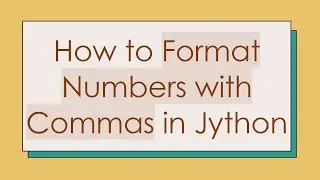How to Reference Containing Objects in Objective-C for iPhone Development
Learn how to effectively reference containing objects in Objective-C, fundamental for iPhone app development utilizing object-oriented programming principles.
---
Disclaimer/Disclosure - Portions of this content were created using Generative AI tools, which may result in inaccuracies or misleading information in the video. Please keep this in mind before making any decisions or taking any actions based on the content. If you have any concerns, don't hesitate to leave a comment. Thanks.
---
In iPhone app development using Objective-C, effectively managing object references is a crucial aspect given its roots in object-oriented programming (OOP). Developers often encounter a common requirement where an object needs to reference its containing object. This necessity usually arises when you have structured your application in a nested object hierarchy.
Consider a scenario where Object B is nested within Object A. There might be instances where Object B needs to perform certain operations involving its container, Object A. This brings up the question: How can Object B reference its containing Object A?
Establishing Object References
To address this question, the simplest and most common approach is to maintain a weak reference from Object B to Object A. This setup not only ensures that Object B can access Object A whenever necessary but also helps in managing memory efficiently, preventing retain cycles which could lead to memory leaks.
Here's a basic pattern to establish this reference:
Declare a Property: In Object B, declare a property that serves as a reference to Object A.
[[See Video to Reveal this Text or Code Snippet]]
The use of a weak property is essential here, as it avoids increasing the retain count of Object A, thereby preventing a strong reference cycle.
Assign the Reference: When initializing or setting up Object B, assign Object A to the container property of Object B.
[[See Video to Reveal this Text or Code Snippet]]
This pattern is straightforward and maintains the hierarchy's integrity while adhering to proper memory management practices by using weak references.
Importance of Containing Object References
Such reference patterns are essential for modular design and maintaining a clear relationship hierarchy among objects within an application. It's particularly beneficial in:
Coordinate Data Flow: Facilitates coordinated actions across the app, where operations in Object B could impact the state or behavior of Object A.
Centralized Operations: Centralized control or operations related to both objects can be efficiently accomplished if Object B can refer back to Object A.
Enhanced Communication: Encourages cleaner communication patterns between nested or related objects in your application architecture.
Conclusion
Understanding how to reference containing objects in Objective-C is paramount to leveraging the full potential of OOP principles in iPhone development. By employing the right reference methods and managing memory prudently using weak references, you can create robust and efficient applications. This skill is a vital asset in your Objective-C toolkit, ensuring app resources are effectively utilized and interactions between object hierarchies are seamlessly managed.
Whether you're refactoring existing code or designing a new application architecture, keeping these paradigms in view will guide lasting and scalable solutions, essential for modern iOS development.































